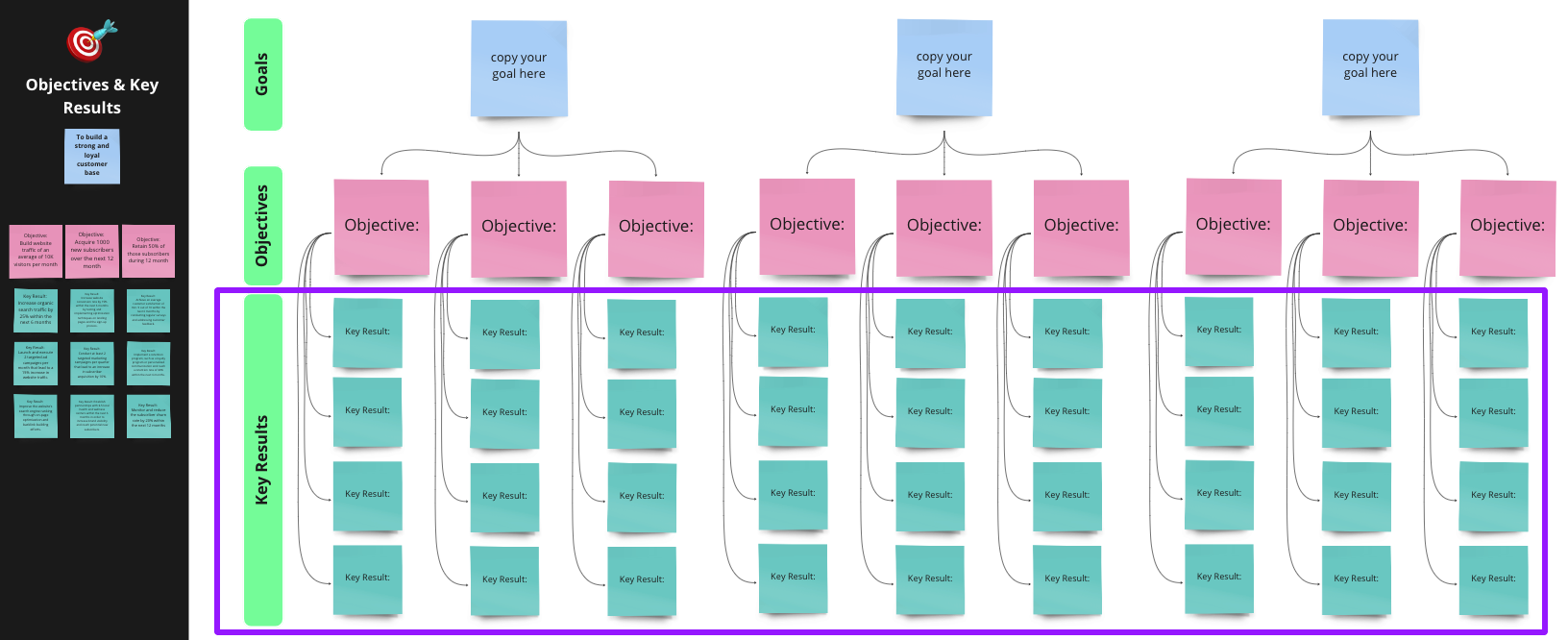Vision & OKR Alignment Guide
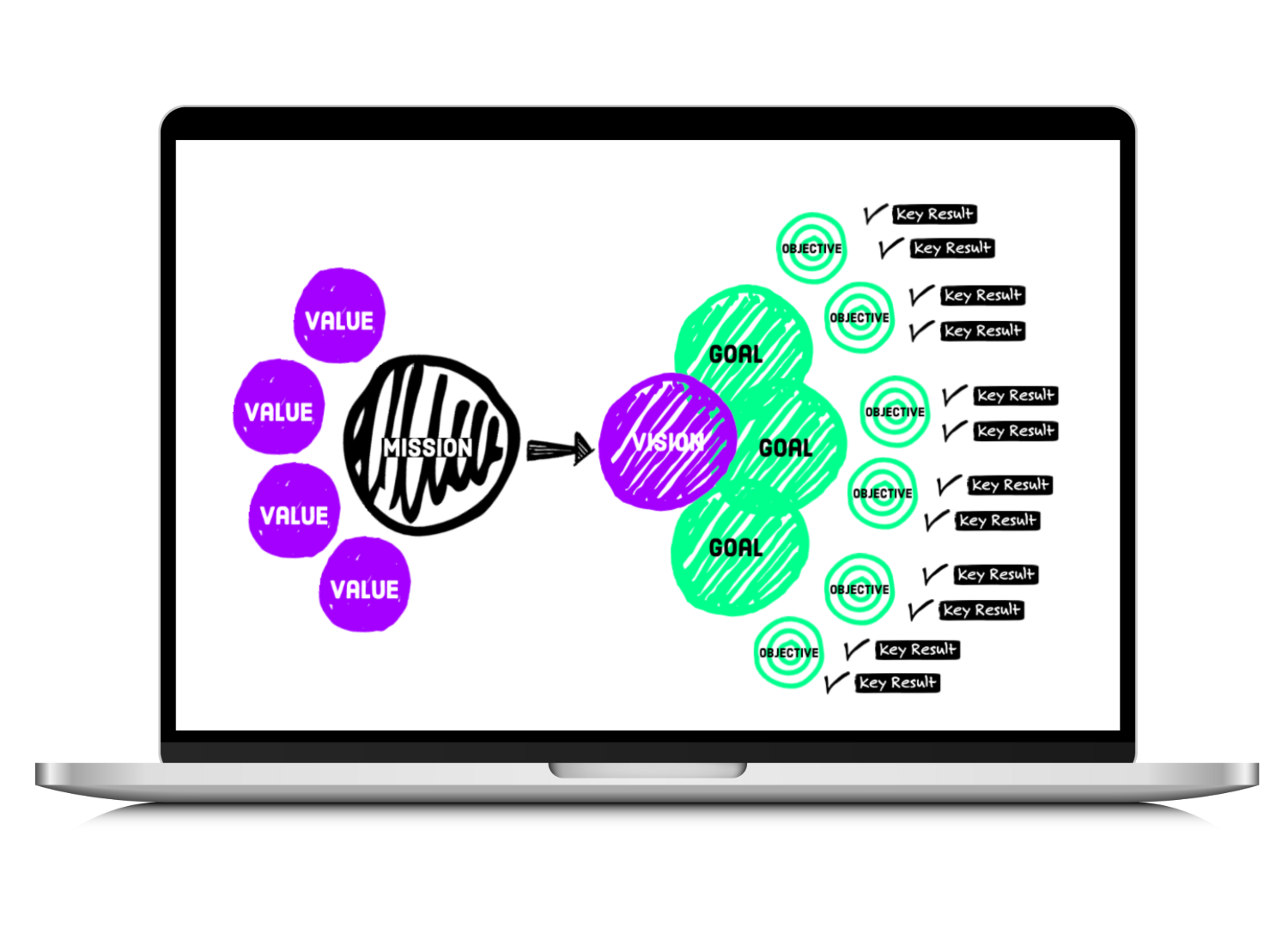
What is Vision & OKR Alignment?
No matter if you are a solopreneur working alone on your venture or if you’re working with a large team, to build a venture that is sustainably successful, you need to be very clear about the mission and vision as well as the objectives of your business. And if you are working with a team, it is essential to be aligned on those aspects to make sure everyone is moving in the same direction.
Therefore, today we will align your vision working in two parts. The first half, we will focus first on developing a common vision, mission, and value for your business. In the second half, we will then dive into determining clear objectives for your business.
Together, your company’s mission, vision, and values help you to define its identity and purpose, and they provide a sense of direction and purpose for the team and stakeholders.
Your company’s vision also entails its goals. The goals are the outcomes you aim to achieve, while your objectives are the specific actions or steps you plan to take in order to achieve those goals. Clear goals and objectives help to ensure that everyone is working towards the same targets.
Note: 🍋 Throughout this guide, we will use the example of a food supplement company to better illustrate each task and information.
What is Vision & OKR Alignment
Good For?
Aligning your company’s vision with Objectives and Key Results (OKRs) is a strategic imperative for success in today’s competitive landscape. This alignment not only provides a roadmap for achieving long-term goals but also ensures that every member of your team is moving in sync towards a common objective.
- Enhanced Clarity: Aligning your company’s vision and OKRs provides clarity to everyone involved, ensuring that each team member understands the overarching goals and how their individual tasks contribute to them.
- Improved Focus: By defining clear objectives aligned with your vision, you can direct your team’s efforts towards the most important tasks, avoiding distractions and increasing productivity.
- Increased Accountability: When goals and objectives are clearly defined and aligned with the company’s vision, it’s easier to hold individuals and teams accountable for their performance, fostering a culture of responsibility and ownership.
- Adaptability: Aligning OKRs with your company’s vision allows you to adapt to changes in the market or business environment more effectively,
How to Define Your Vision & OKRs Step-by-Step:
Step A: Company Vision Alignment Template
Step B: Value Identification
Step C: Mission Statement
Step D: Vision Statement
Step E: Setting Objectives
Step F: Key Results Definition
Step A
Vision & OKR Alignment Template
To work on your vision and OKRs you can either build your own whiteboard template for example on Miro or you can use our ready-to-use template along with this guide.
Included Templates:

Vision & OKR Alignment Miro Board
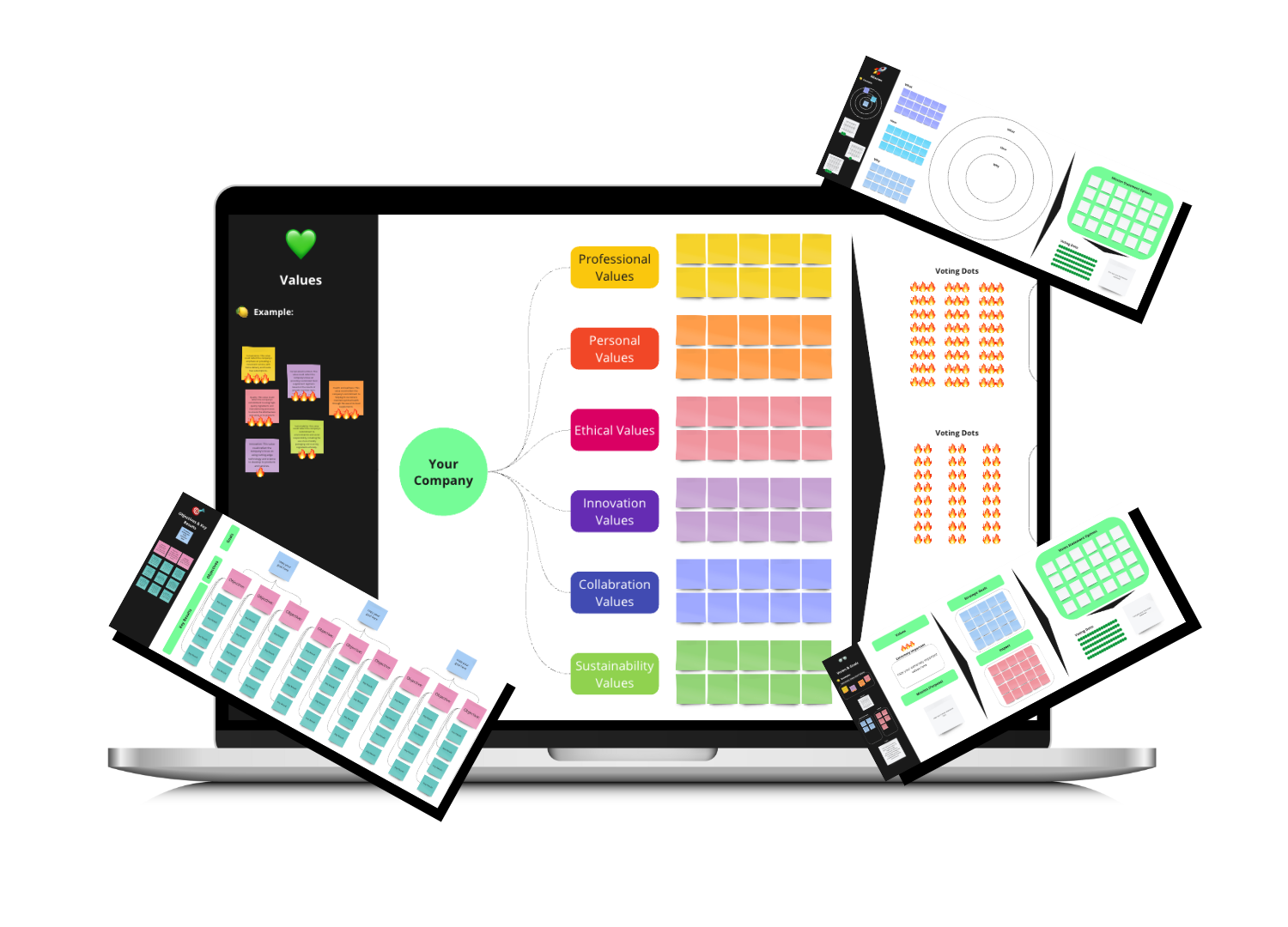
Step B
Value Identification

So, let’s get started and begin by defining your values.
Values are the guiding principles that shape your company’s culture and influence the way it conducts business. They form the foundation of your company’s beliefs and reflect its fundamental approach to the world.
There are different types of values, such as:
- Professional values: These values relate to the way your company conducts itself in its business and professional relationships, such as integrity, professionalism, and excellence.
- Personal values: These values relate to the way your company treats its employees and stakeholders, such as respect, fairness, and inclusivity.
- Ethical values: These values relate to the way your company behaves in an ethical and socially responsible manner, such as honesty, transparency, and responsibility.
- Innovation values: These values relate to the way your company approaches problem-solving and innovation, such as creativity, adaptability, and continuous learning.
- Collaboration values: These values relate to the way your company works with others, both internally and externally, such as teamwork, cooperation, and collaboration.
- Sustainability values: These values relate to the way your company approaches environmental and social sustainability, such as conservation, social responsibility, and sustainability.
Think about or brainstorm with your team to determine which values apply to your business. What is important to you and your team, and therefore your company? What does it stand for and represent? Which principles guide the way your company works and does business?
The values can be described in single words or full sentences, and you do not have to find values in each of the above categories, but they can serve as a guide.
☝️ Record everything on the first part of your Vision Alignment 📒Template and use the voting dots to classify the values by their level of importance. If you’re working with a team, vote for the most important values. Each person gets 9 votes in total, with 3 votes per level.
- The extremely important values are the ones you want to base your mission and culture on and that define your business internally and externally.
- The very important values should be followed in day-to-day operations and be incorporated into your rules of conduct.
- The important values should be respected whenever possible.
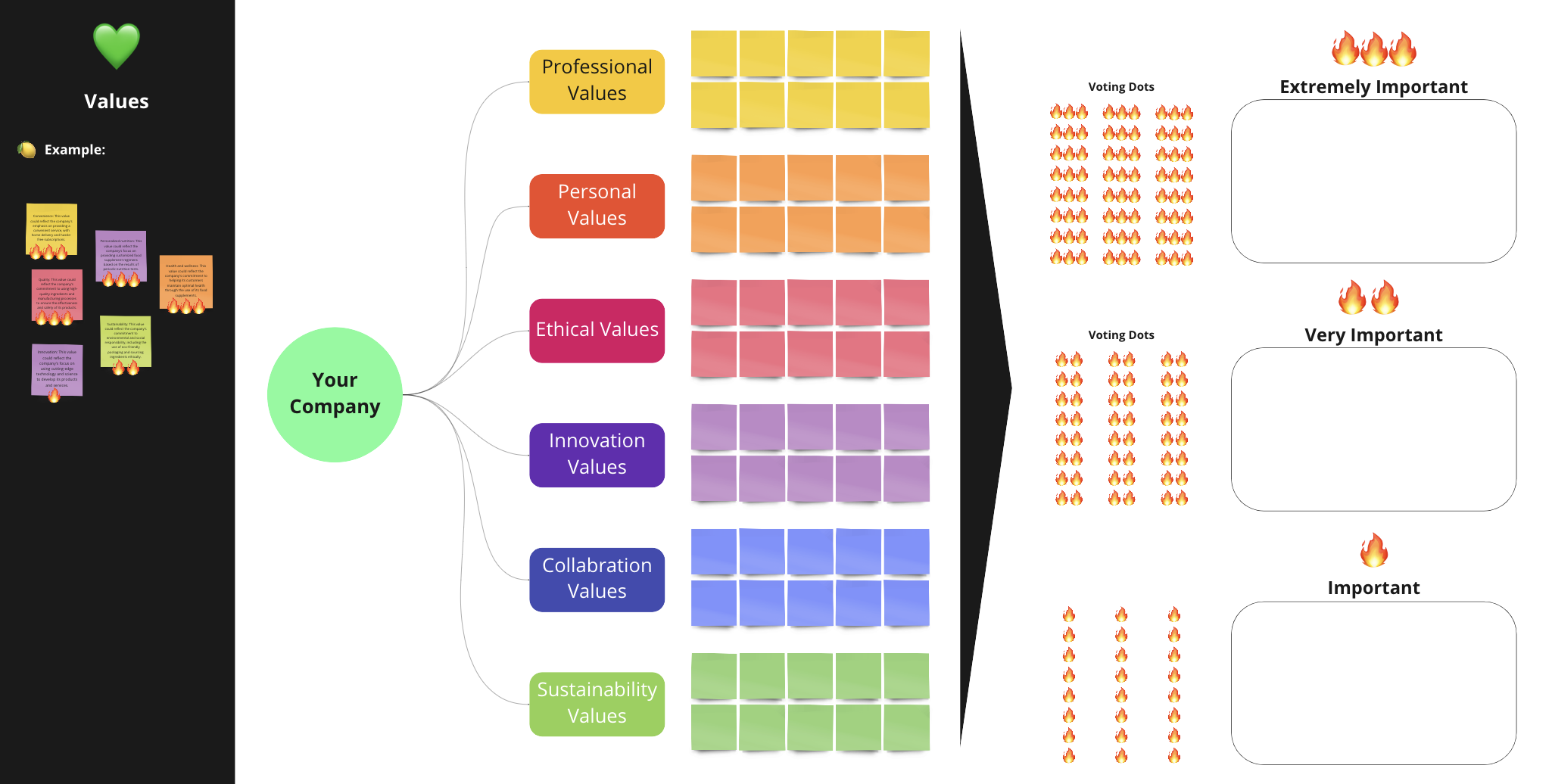
Step C
Mission Statement

With your values in mind, let’s formulate your mission statement.
The mission is your company’s reason for being – the purpose it serves. It’s a statement that describes your business’s fundamental goals and the ways in which it aims to achieve them. A company’s mission is often closely aligned with its values, which are the guiding principles that shape its culture and inform the way it does business.
A great tool to define your company’s mission and vision is the “Golden Circle” developed by Simon Sinek. The Golden Circle consists of three elements: why, how, and what.
- The “why” refers to the purpose or belief that drives an individual or organization. It’s the reason they do what they do.
- The “how” refers to the unique processes or methods used to achieve the “why.”
- The “what” refers to the products or services that an individual or organization provides.
Sinek argues that most organizations start with the “what” (i.e., what they sell) and work backward, while the most successful organizations start with the “why” (i.e., their purpose or belief) and work outward. So let’s get it right from the start, and take a look at the “why”!
☝️ Think about how you/the team would answer the following questions and collect your answers on the Vision Alignment 📒Template.
Why:
What is the reason your business exists? What is your company’s purpose, and what are your core beliefs? What does your company bring to the world?
How:
How do you put the “why” into action? What are you doing differently from competitors, what makes you special? What values and principles guide your actions?
What:
What is it that you actually do? What is the outcome of the “why”? What products and/or services do you offer?
Next, based on this, you want to formulate possible mission statements. No matter if you are working on your own or brainstorming with your team, collect different options for your mission statement and note them down on your whiteboard.
When formulating your mission statement keep in mind the following factors:
- Alignment with company values & purpose: The mission statement should align with and reflect the company’s values and the purpose which you just defined.
- Clarity: The mission statement should be clear and concise, and it should be easily understood by employees and stakeholders.
- Specificity: The mission statement should be specific, outlining the specific goals that the company aims to achieve and the ways in which it plans to achieve them.
- Relevance: The mission statement should be relevant to the company’s stakeholders, addressing their needs and concerns and explaining how the company plans to meet them.
- Aspiration: The mission statement should be aspirational, reflecting the company’s long-term goals and ambitions and inspiring employees and stakeholders to take action.
- Authenticity: The mission statement should be authentic, reflecting the company’s true purpose and identity.
✅ Finally, vote for your ultimate mission statement. If you are working with your team, everyone gets one voting dot and can select her/his preferred option. Then note down the selected mission statement in the respective area of your Vision Alignment 📒Template.
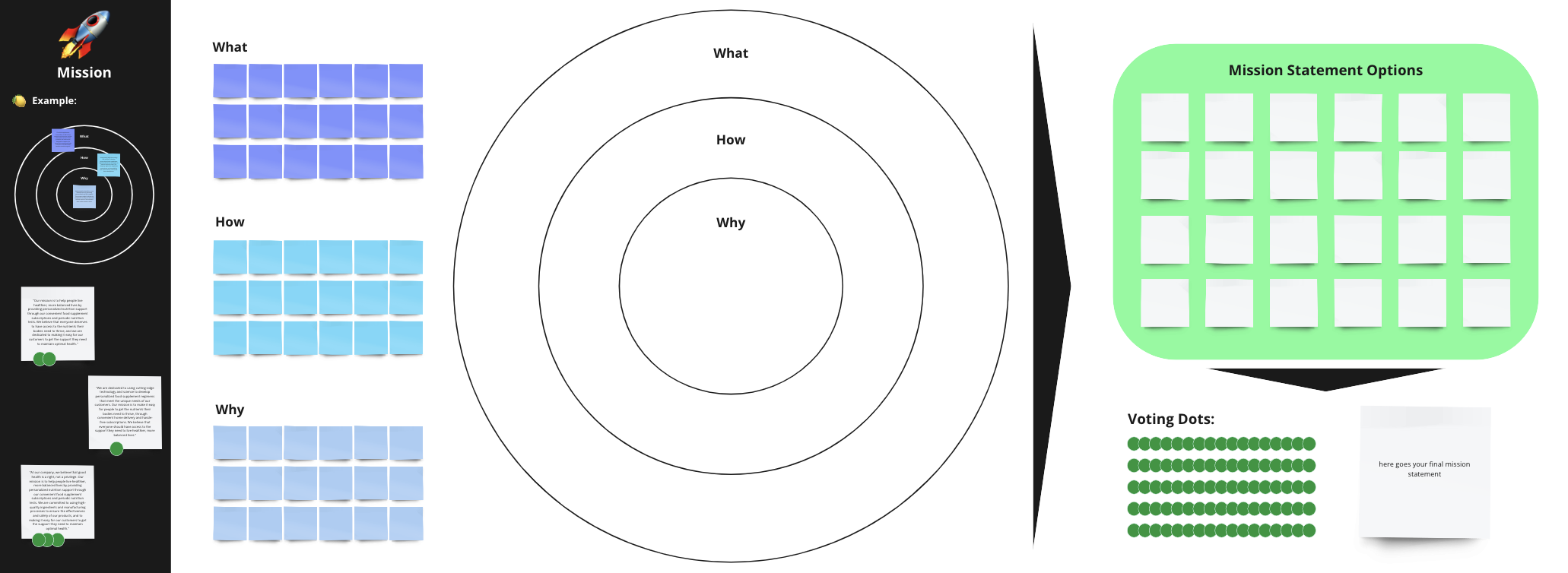
Step D
Vision Statement

Alright, now that you’ve defined your mission statement, let’s move on to your company’s vision.
The vision is a statement of your business’s long-term aspirations, describing the future it hopes to create for itself and its stakeholders. A vision statement is often more ambitious and aspirational than a mission statement. It helps guide your company’s decisions and actions as it works towards its long-term goals, and provides a sense of direction and purpose for its employees and stakeholders.
A vision statement typically includes the following elements:
- The company’s long-term goals and aspirations
- The values and principles that will guide the company’s actions as it works towards its vision
- The impact the company hopes to have on its stakeholders and the wider world
It should be inspiring, motivating, and achievable, and it should reflect the company’s authentic purpose and identity. It is an important part of a company’s overall strategy, defining its long-term direction and purpose.
✅ So, go to your Vision Alignment 📒Template and follow these steps to define your vision statement:
- Bear in mind your company’s values and purpose: Keep in mind the values and mission you defined in the previous two steps when formulating your vision statement.
- Define your strategic goals: Identify your company’s long-term aspirations, the future you hope to create for yourself and your stakeholders, and the outcomes you want to achieve in the long-term.
Some common types of goals for a company might include financial goals (e.g., increasing profits or revenue), growth goals (e.g., expanding into new markets or increasing market share), operational goals (e.g., improving efficiency or reducing costs), and social or environmental goals (e.g., reducing carbon emissions or improving working conditions).
- Determine the impact you hope to have: Consider how you want to make a difference in the world through your company’s actions and products, and what impact you want to have on your stakeholders and the wider world.
- Craft your vision statement: Using the information you have gathered, create a statement that describes your company’s long-term aspirations, guiding its decisions and actions. Be specific and concise, and aim for a statement that is inspiring, motivating, and achievable.
Remember that your vision statement may evolve over time as your company grows and changes. It’s a good idea to review and revise it periodically to ensure it continues to accurately reflect your company’s long-term goals and aspirations.
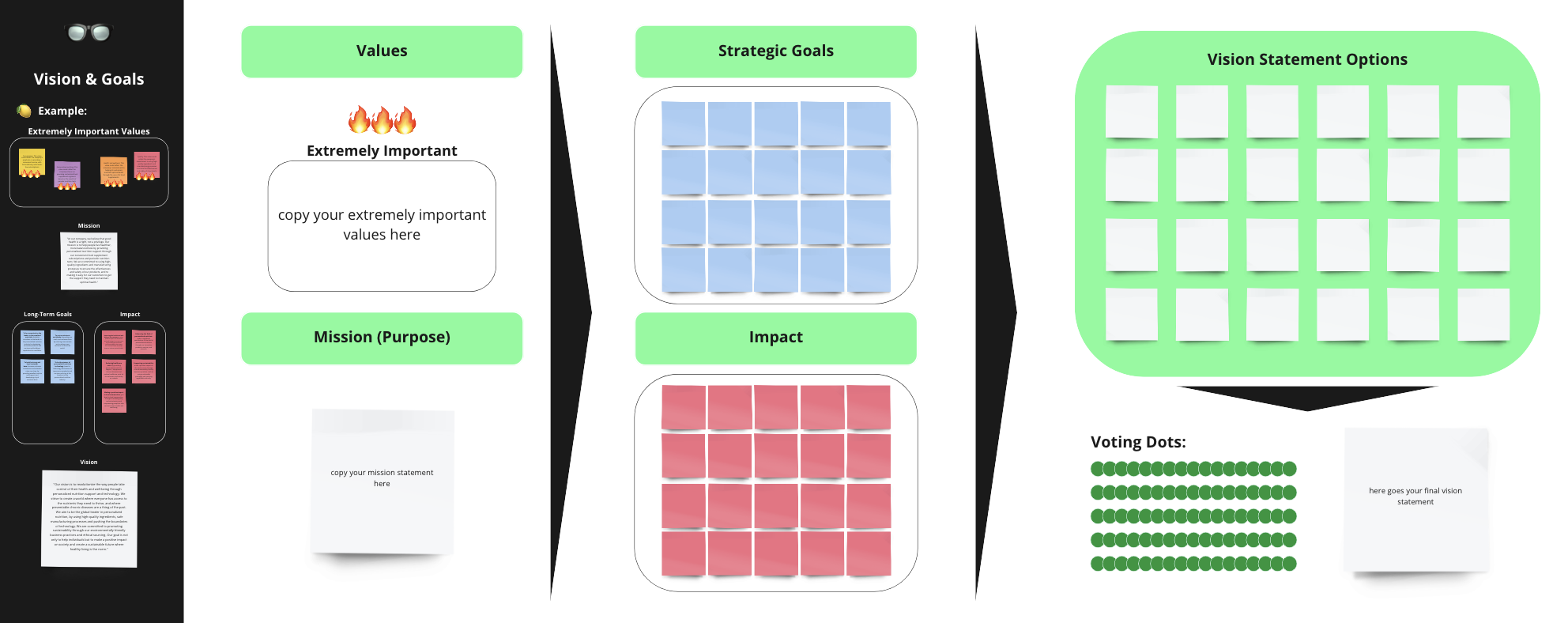
Step E
Setting Objectives

Now that you are clear about your vision and have defined your company’s long-term goals, let’s specify how you are going to achieve them by looking at your OKRs.
OKRs stand for “Objectives and Key Results,” a goal-setting framework used to set and track progress toward specific, measurable objectives. The framework includes clear and specific objectives that are aligned with the overall company strategy, as well as a set of key results used to measure progress toward both short-term and long-term objectives.
While your company’s goals are the high-level outcomes it aims to achieve, its objectives are the specific and measurable descriptions of what exactly you are planning to achieve and the actions you plan to take in order to do so.
It’s important to regularly review and revise these goals and objectives to ensure that they are still relevant and aligned with the company’s changing needs and circumstances. This helps to ensure that your company stays focused and on track as it works toward its long-term goals.
Let’s dive into defining your objectives. In the last step, you determined your strategic long-term goals. Now, focus on defining the objectives you want to achieve in the next 12 months that contribute to fulfilling those long-term goals.
Choose the most important goals from your list (a maximum of 5 goals) and copy them to the “Objectives & Key Results” area of your whiteboard. Then, define one or more objectives for each of those goals.
When defining your objectives, keep in mind that they should be SMART:
- Specific: The objective should be specific and answer the questions of what, why, and how.
- Measurable: The objective should be measurable so that progress can be tracked and the objective can be determined to be achieved.
- Achievable: The objective should be achievable and realistic given the resources and constraints of the organization.
- Relevant: The objective should be relevant and aligned with the overall strategy and goals of the organization.
- Time-bound: The objective should have a specific deadline or timeframe within which it should be achieved.
For example, for the long-term goal “To build a strong and loyal customer base,” a possible SMART objective could be:
“Build website traffic of an average of 10K visitors per month.”
- Specific: Build website traffic of an average of 10,000 visitors per month within the next year.
- Measurable: Track website traffic through web analytics and compare it to the goal of 10,000 visitors per month.
- Achievable: Invest in online advertising, search engine optimization, and other marketing strategies to increase visibility and attract more visitors to the website.
- Relevant: This objective is directly relevant to the company’s long-term goal of building a strong and loyal customer base.
- Time-bound: The objective should be achieved within the next year.
✅ Go ahead and define your objectives for each goal and note them down in the respective area of your Vision Alignment 📒Template.
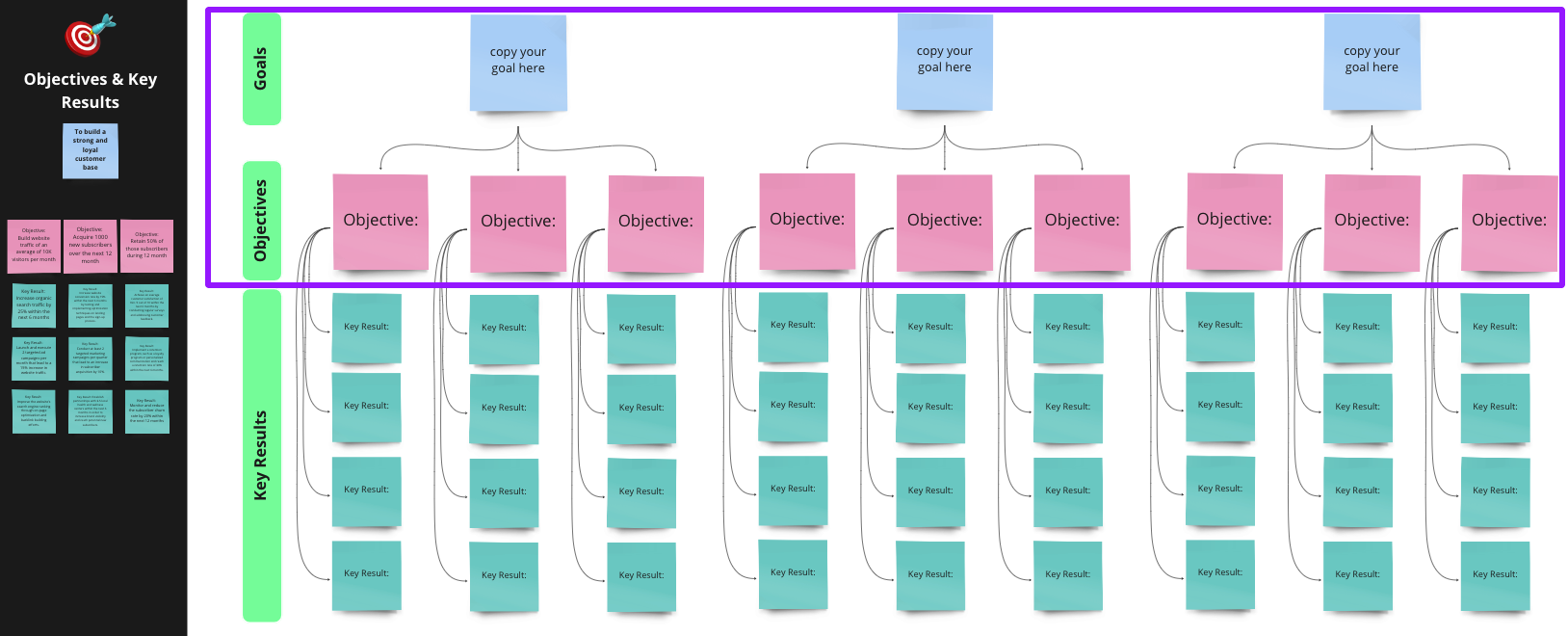
Step F
Key Result Definition

Now let’s move on to defining your key results for each of the objectives.
The key results are metrics used to track progress towards achieving an objective. They are typically used to answer the question of how an objective will be achieved. Key results are closely related to the objective they are associated with, and the achievement of key results directly shows the progress of achieving the associated objective.
Key results are specific and measurable, aligned with the overall objective, have a deadline or time-frame within which they should be achieved, and have defined actions and ways to track them. This allows for the identification of areas that need attention to get back on track with the objective.
✅ So go ahead and think about possible actions and steps that you want to take to achieve the objectives, and note them down on the respective area of your Vision Alignment 📒Template.
For example, possible key results for the objective “Increase website traffic to an average of 10K visitors per month” could be:
- Increase organic search traffic by 25% within the next 6 months.
- Launch and execute 2 targeted ad campaigns per month that lead to a 15% increase in website traffic.
- Improve the website’s search engine ranking through on-page optimization and backlink building efforts.
